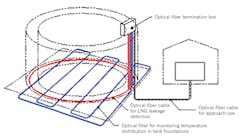Greg: Here we enjoy some war stories on material selection by Hunter Vegas, senior project manager at Wunderlich-Malec Engineering in Greensboro, N.C., a cofounder and key resource of the ISA Mentor Program revitalized by the Nov. 16, 2015, Control Talk blog entry, “Invitation to join the expanded ISA mentor program." Hunter is a great complement to my knowledge in first principles and control concepts as he has worked on a lot of projects and has seen firsthand what works and doesn’t work. He's driven like me to help our protégés and protégées, and advance our profession.
Hunter: Some automation engineers have the luxury of working with relatively simple or benign chemistry. Unfortunately, nearly all of my clients routinely work with “methyl ethyl death” or one of its many variants. I keep hoping for the dream automation retrofit job at a doughnut factory or an ice cream plant, but no luck so far.
Greg: I love old-fashioned doughnuts. We could get into our favorites, but we might have to change the name of this column to “Doughnut Talk.” Cartoons could feature the “Doughboy.” Hmm, maybe this is not a bad idea, we might pick up more readers.
Stan: Given that many plants have hazardous materials and many other substances that attack materials of construction, where are we in being safer?
Hunter: The art of instrumentation specification and material selection is rapidly being forgotten. Large companies are downsizing their engineering groups, and tossing instrumentation specification over the fence to the vendors. Unfortunately, the vendors rarely know the process or understand the chemistry involved. This can lead to mistakes in materials selection, and result in dangerous and even deadly consequences. Even when the right materials are specified, the wrong equipment can be shipped, often creating in an equally bad situation. The purpose of this discussion is to raise awareness of the issue, encourage controls engineers to evaluate their process, and choose instrumentation materials carefully.
Greg: What are some of the red flags?
Hunter: After 30-plus years of automation projects, one develops an ability to spot red flag issues as they're encountered. As soon as I recognize a red flag issue for what it is, I immediately begin asking for a lot of details. Many chemicals fall into my red flag zone, but some of the more common ones are anhydrous ammonia, chlorine, oxygen, peroxides/strong oxidizers, hydrogen cyanide, acids (hydrochloric, hydrofluoric, nitric, sulfuric, etc.), strong bases, carbon dioxide (with water), zinc/magnesium/sodium, hydrogen sulfide, and any chemical I don’t know. Each of these (and many others) can bite you in new and unexpected ways if you're not diligent in your specifications.
Stan: Obviously, we can’t elaborate on all of the “gotchas” of each, but give us some quick examples, given that we need to allow time to go get some doughnuts.
Hunter: Here are some particularly challenging chemicals that come to mind:
Anhydrous ammonia—It's explosive at high concentrations, dissolves Viton, reacts explosively with water, and will readily attack copper or any copper-bearing alloy. It can also create enormous water hammer if allowed to vaporize in a long pipe.
Hydrogen cyanide (HCN)—It's flammable and a deadly poison, but it also reacts explosively with almost everything. It will explosively polymerize with high-pH material and low-pH material, and can even explode if just left alone in a dead leg. It enters the pores of Teflon and polymerizes, puffing it up like popcorn, and will attack most other soft goods as well. It also polymerizes in nooks and crannies, freezing up control valves and any moving equipment. The number of explosive incidents involving this chemical is legion. One client had a small storage tank of HCN detonate. They did some testing to determine how big a PSV or rupture disk it would take to adequately protect the vessel, and the results indicated it would take a rupture disc bigger than the tank! They gave up and just eliminated the storage tank, feeding the chemical straight from the producer to the user with a small surge vessel in between the plants.
[sidebar id =2]
Sulfuric acid—This very common chemical poses a number of material selection challenges because it attacks different materials at different temperatures and concentrations. Carbon steel works great at high concentrations, but dissolves as the concentration falls. Similarly, fiberglass is great for dilute sulfuric acid, but is attacked if the concentration is too high. Concentrated sulfuric acid reacts violently with water and generates large amounts of heat. Many exotic alloys (and fiberglass) can easily handle dilute acid at low temperatures, but fail at higher temperatures. Sulfuric acid also liberates hydrogen gas as it reacts with metals, so tanks tend to gather hydrogen in the head space. Needless to say, sulfuric acid reacts explosively with bases. Many processes require dilution of sulfuric acid, but that's very difficult to do given the heat and wide range of acid concentrations encountered.
Oxygen—This gas is just looking for a chance to react with anything and the reaction is usually explosive. A little bit of grease is all it takes to start the reaction and the temperatures are so high, the oxygen will start burning the metal pipe walls around it. One client had a Superior orifice fitting on a high-pressure oxygen line explode one night for no apparent reason. After an extensive investigation they still aren't certain what happened, but think a well bead from some upstream straightening vanes struck the Monel orifice, and somehow started the explosion.
Nitric acid—This acid violently reacts with many organics. One client learned that the hard way when a pump exploded and the impeller head was thrown through a cinder block wall. (Thankfully, nobody was hurt.)
Stan: Even if you think you’ve got the application covered, what can go wrong?
Hunter: Even when you're aware of the dangers and specify the right materials, an error in the order process can occur. I once specified a pressure transmitter for high-pressure ammonia service and selected the proper non-Viton O-rings. The vendor used the correct O-rings inside the transmitter, but used the standard Viton O-rings for the manifold. We installed the transmitter, and I put it in service by opening the isolating valves. The transmitter starting reading, so I turned and had taken three steps toward the control room when I heard an increasingly angry hiss. I looked back and saw an ammonia vapor cloud enveloping the transmitter.
Sometimes it isn’t the chemistry that bites you, but the unanticipated process conditions. An engineering firm specified a magmeter for a urea slurry application and the meter worked great—until Production steamed it out and blocked in the pipe. As the steam condensed, the meter was subjected to a full vacuum, which collapsed the liner and destroyed the meter.
In other cases, a slight change in the process can have very unexpected results. One plant decided to replace the heating medium of a reactor feed exchanger with high-pressure steam condensate, rather than high-pressure steam, to increase heat transfer and raise plant rate. This worked wonderfully until we began running process safety vent (PSV) sizing calculations, and realized that if a tube failed and water reached the reactor, then the material inside would disassociate into very large amounts of carbon dioxide and ammonia. The PSVs could handle a tube failure with steam, but a tube failure with water would generate several times more vapor. Fortunately, the issue was corrected before a tube leak occurred.
Greg: Whether a material will fail depends on concentration, temperature, pressure and many other process conditions including multiple phases (droplets in vapor, bubbles in liquids and solids in any fluid). Velocity also accelerates corrosion and erosion. In some cases, the results are counterintuitive. For example, sulfuric acid concentrations greater than 95% are less corrosive, enabling the use of stainless steel.
Hunter: Selection of control valves must include the effects of cavitation, erosion, chemical attack, polymer buildup, etc. We had one valve in a urea plant taking a 1,500 psi drop of urea/carbamate solution. Between the chemical attack, incredible velocities, sound levels and flashing conditions, we couldn’t find a valve that would last a week. We ultimately ended up taking a solid block of Ferralium and machining a valve out of it. It cost $60,000 for a 2-in by 6-in. valve.
Greg: pH has been near and dear to my heart. Electrode o-rings are often the overlooked weak link. While the glass can tolerate many conditions, hydrofluoric acid can do great damage below 5 pH. High concentrations of strong acids and non-aqueous solvents deplete the critical hydrated layer at the glass surface. Sodium ions from high caustic and salt concentrations can penetrate the glass, causing a sodium ion error. Reference electrodes are particularly challenging because proper measurement of pH depends on the internal electrolyte of the reference being in contact with the process to complete the electrical path to the measurement electrode. Pressure fluctuations and driving force that promotes the migration of ions from high to low concentrations result in process ions entering via the liquid junction into the internals of the reference electrode. Cyanides, sulfides, iodides or nitrates can cause precipitation of the silver of the internal silver electrode and silver chloride electrolyte. Double and triple junctions and solid-state references can slow down contamination at the internal electrode, but in general, special electrolytes and electrodes are recommended. References with multiple or solid-state (porous polymers with electrolyte) junctions are generally much slower to reach equilibrium, posing challenges in the calibration and replacement of electrodes and being able to monitor the pH in the short cycle times of many chemical batch operations. In high-ionic-strength streams, the liquid junction potential can cause an error of 0.5 pH or more, and require hours to equilibrate (stop drifting). A flowing junction reduces contamination issues, equilibrates in a few seconds, and has the least junction potential. The requirement of an adjusted pressurized reservoir to ensure a small positive junction flow and keep the electrode completely full is challenging for varying process pressures making these electrodes unpopular in the U.S. despite their significantly better accuracy.
Stan: What are some parting words of wisdom?
Hunter: Automation engineers tend to focus on electrical and software issues because they understand them. However, the enormous hazards associated with chemistry and material selection warrant our attention and diligence. If you're working with unfamiliar chemicals, take the time to find the process engineer and ask a lot of questions. He'll be thrilled to expound on his field and you'll exit the conversation a much wiser (and safer) automation professional.
Top 10 reasons why doughnuts are a poor choice for material of construction
(10) They make poor orifice plates
(9) Keeping the pigeons away would become a full-time job
(8) Pilferage in the stores warehouse would rise dramatically
(7) Oozing jelly leaks tend to freak out enviro folks
(6) The costs to widen the control room doors and reinforce the chairs could get prohibitive
(5) Doughnut companies could take over the instrument market and collude on pricing
(4) Powdered sugar messes up product clarity specs
(3) Inspection department keeps insisting on “destructive testing” of the equipment
(2) Doughnuts adversely affect the bottom line making pants a tight fit
(1) Operators keep eating all of the profit
[sidebar id =1]



